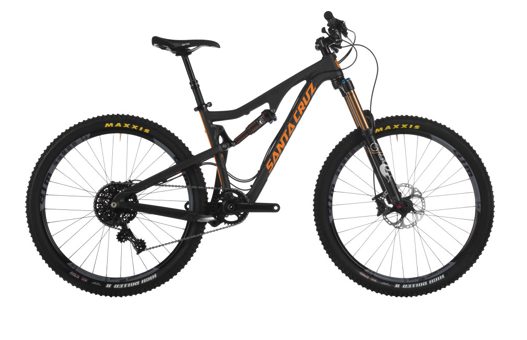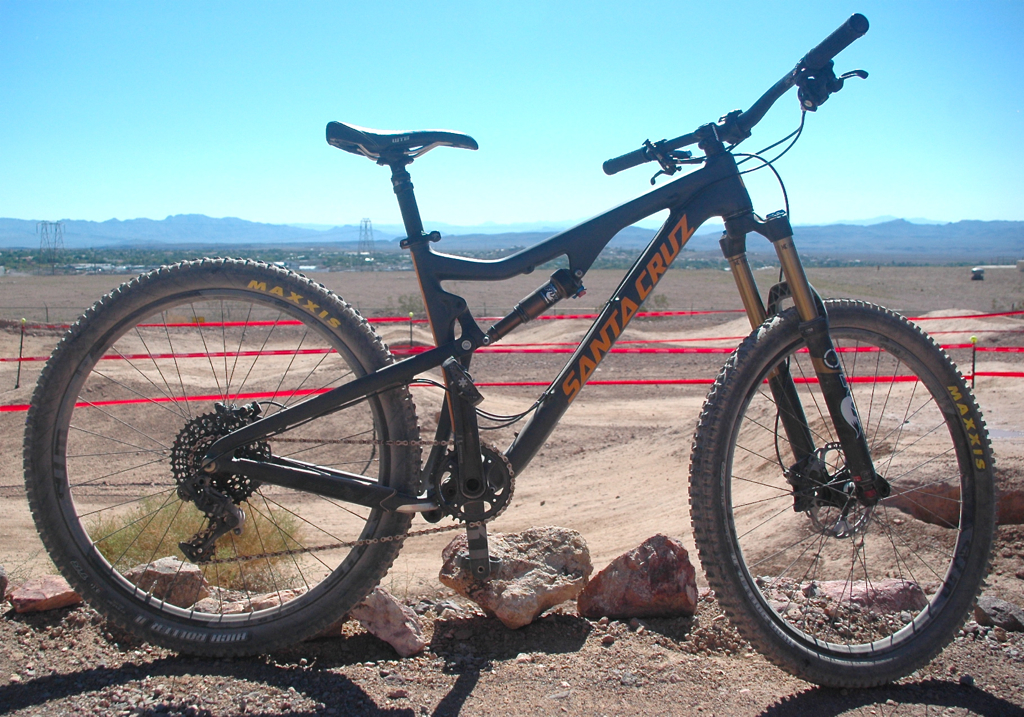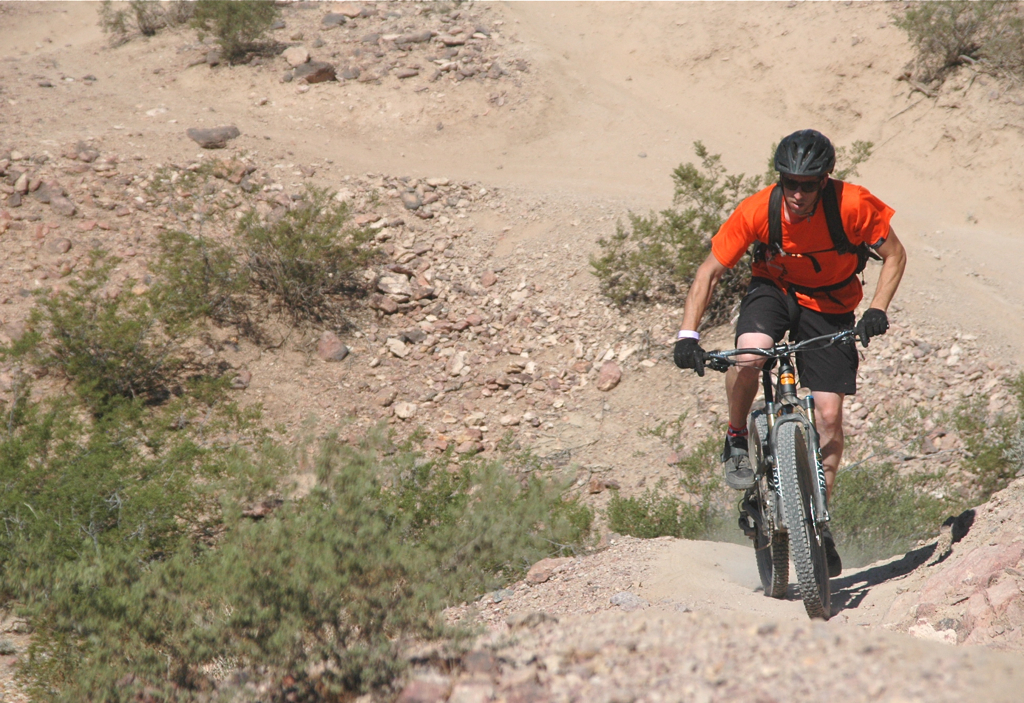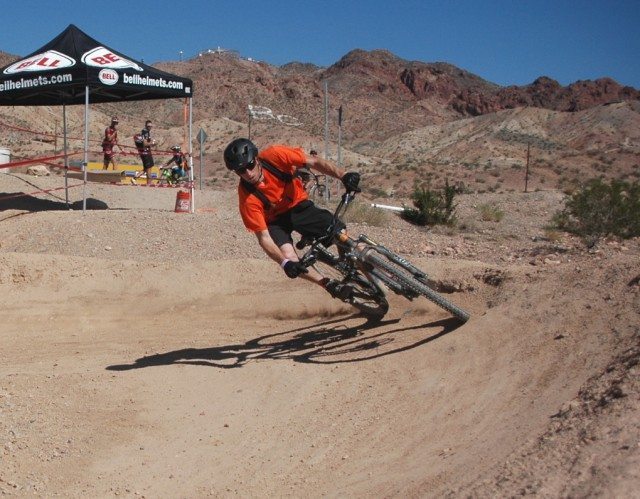
2014 Santa Cruz Bronson Carbon
Size Tested: Medium
Wheels: 27.5″
Travel: 150mm
Rider Info: 5’9”, 150 lbs.
Days Tested: 1
Locations Tested: Boulder City, Nevada
The Caveat
Last week, we tested bikes on the rocky trails around Boulder City, Nevada during the Interbike Outdoor Demo. We’ll keep rolling out First Looks of the other bikes we rode (including the Yeti SB95 and the GT Fury), so stay tuned. But before we get to our initial impressions of the Bronson, an important caveat:
(And if you’ve already read the intro to the review of the Pivot Mach 6 or the Devinci Troy, feel free to skip this part and scroll down to First Impressions.)
Riding bikes at a demo is always kind of tricky. For starters, we didn’t get much time on each bike—at most around an hour, and with many bikes it was just a 25-minute loop. 25 minutes can tell you a lot about how a bike handles, but it certainly doesn’t allow for our customary in-depth, BLISTER analysis.
In addition, these bikes are set up by mechanics at each company’s booth, and while these guys do a great job, there isn’t really time to get each bike dialed for how I’d normally set it up. (If nothing else, I probably would have put wider bars on most of the bikes I rode.)
And then there are the trails. Interbike’s Outdoor Demo takes place at Bootleg Canyon in Boulder City. It’s a little bastion of awesomeness that overlooks the pit of despair that is Las Vegas, and the trails are fantastic: super rocky, with lots of sand, some rocks, some jumps here and there, and did I mention the rocks? Most of my time on these bikes was spent on the more cross-country oriented trails, even though the DH trail system is (in my opinion) the crown jewel of the Bootleg trail network.
The XC trails have a good mix of flowy corners, short punchy climbs, rock gardens, and a bit of chunder. All in all, they’re decent for testing out the different aspects of a given bike, but to really develop a feel for how a bike works, there’s no substitute for riding it for a long time on a lot of different types of trails.
So with all that in mind, let’s talk about the Bronson.

First Impressions
The Bronson is Santa Cruz’s newly introduced carbon wonder bike, bridging the gap between the shorter travel Blur and 5010, and the the longer travel Nomad. The Bronson sports 27.5″ wheels, 5.9″ of VPP suspension, and geometry numbers that are primed for a full blown, brown pow assault on both the climbs and the descents. I spent some time on a medium Bronson, and walked away thoroughly impressed.
Suspension
It had been a while since I’d spent much time on a VPP bike, and most of my experience with Santa Cruz bikes was on older VPP designs. I wasn’t a big fan of those bikes—the suspension lacked support when I wanted it, and the bump compliance wasn’t good enough to make up for its other shortcomings.
So I went into this test ride with a bit of skepticism. I knew Santa Cruz had done a fair amount of tweaking of the VPP design over the years, but I didn’t expect it to be as good as it was.

The first thing that was apparent was that the Bronson pedals really well. Even with the Fox Float CTD shock on “Descend,” there was hardly any pedal-induced suspension movement. Out of all the bikes I rode at Interbike, the Bronson pedaled the best.
Ok, I knew it pedaled well, so I figured that would mean that it would be entirely unimpressive once I started pinging off of rocks. And again, I was wrong. The Bronson leveled out terrain as well as any other bike I’ve ridden in it’s class. The suspension didn’t dive into its travel at inappropriate times; rather, it offered a nicely controlled compliance over the rough stuff.
A Few Comparisons
Of everything I rode at Interbike, the obvious peers of the Bronson are the Giant Trance (review to come) and the Devinci Troy. The Bronson’s chainstays are about .4″ longer than the Troy, a noticeable difference. Where the Troy felt flickable, the Bronson is more inclined to hold its line. This is a bad thing if you’re trying to rally around a tight corner, but it’s a good thing if you’re plowing through a rock garden.
The Bronson has very similar geometry numbers to the Trance, but I felt that the Bronson was a little more responsive to rider input. This isn’t to say that the Bronson is more playful or less stable than the Trance, the suspension just feels a little more dialed and you can get more out of it by pumping through the terrain.
Also keep in mind that the above comments are splitting some pretty narrow hairs. In particular, the Bronson and the Troy bear a lot of similarities. The advantages of one bike over the other are fairly minor. I’d give the nod to the Bronson for pedaling efficiency and stability in a straight line, while I’d lean toward the Troy for corning and maneuverability.
The Bronson can also be compared to the Pivot Mach 6—both have 27.5 wheels and both have around 6″ of travel. But these two bikes are entirely different beasts; the Bronson falls a little more at the trail bike end of the spectrum, while the Mach 6 feels much more inclined toward rowdy, steep descents, and would probably be better compared to the Santa Cruz Nomad (a bike I didn’t get a chance to ride at Interbike, but you can read our review of it here).
I should also note the Bronson’s fraternal twin, the Heckler. The current iteration of the Heckler also has 5.9″ travel, has virtually identical geometry numbers to the Bronson, and is also built around 27.5″ wheels, but it uses a high single pivot suspension design rather than the VPP linkage. This saves a bunch of money; the Heckler sells for quite a bit less than the Bronson.

Tires
In most of these Interbike first look write ups, I’m not spending much time talking about the parts. I will, however, give credit to Santa Cruz for ktting out the Bronson demo bike with Maxxis High Roller tires. A lot of the demo bikes were clad with lighter weight rubber, which keeps the bike’s overall weight down (a good thing), but pretty much sucks in all other respects (sucking at most things is bad). The High Rollers on the Bronson aren’t the lightest tires on the market, but they’re an excellent tire choice for a bike that likes to be ridden hard.
Bottom Line
Overall, I was both surprised and thoroughly impressed by the Bronson. For anyone looking for long-ish travel bike that’s just as happy going up as it is going down, the Bronson is a great choice. And for long rides on technical or rough trails, the Bronson is probably one of the best options out there.

Is there a full Bronson review expected in the future?
Hey Fraser – that’s a good question that unfortunately I don’t have an answer to right now. We’re going to try to get our hands on a Bronson to do a more in depth test, but it’s not clear at this point whether that’ll come together. Check back for updates!
When is the Giant Trance review coming? Did you get any time aboard the Trance Advanced SX?
Hey Sean – the Trance review should be up in the next couple of days. Unfortunately no time aboard the Advanced SX – I only got to ride the Trance 1. The frame geometry is identical, but the SX (both the aluminum and carbon versions) end up with a bit different numbers due to the longer travel fork.